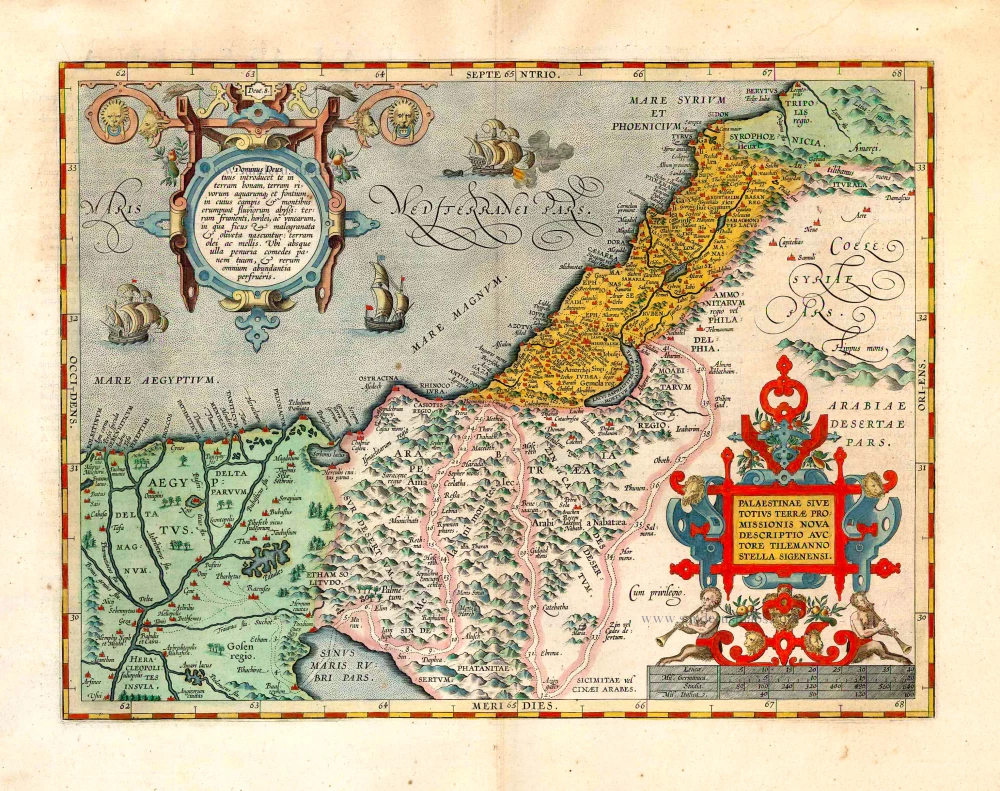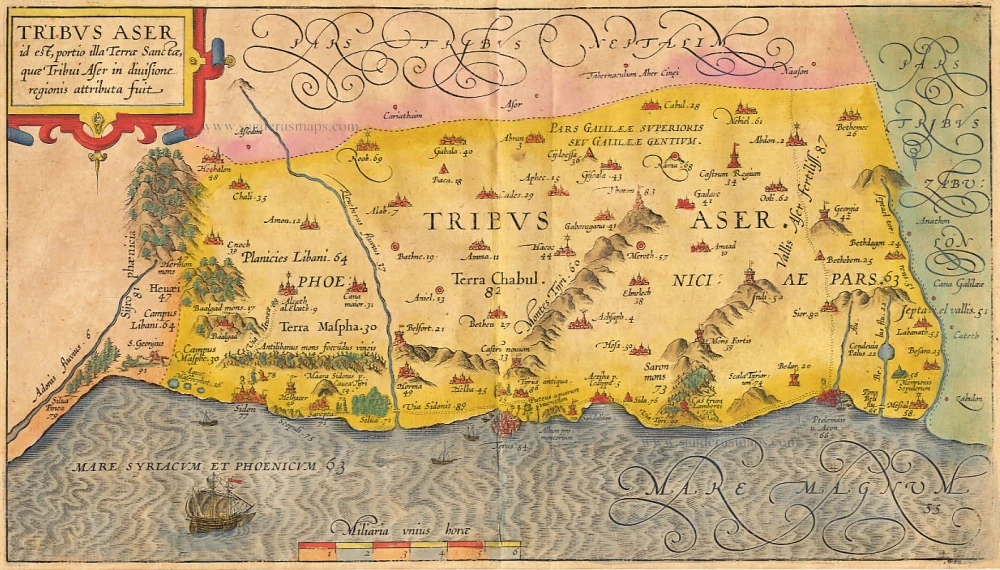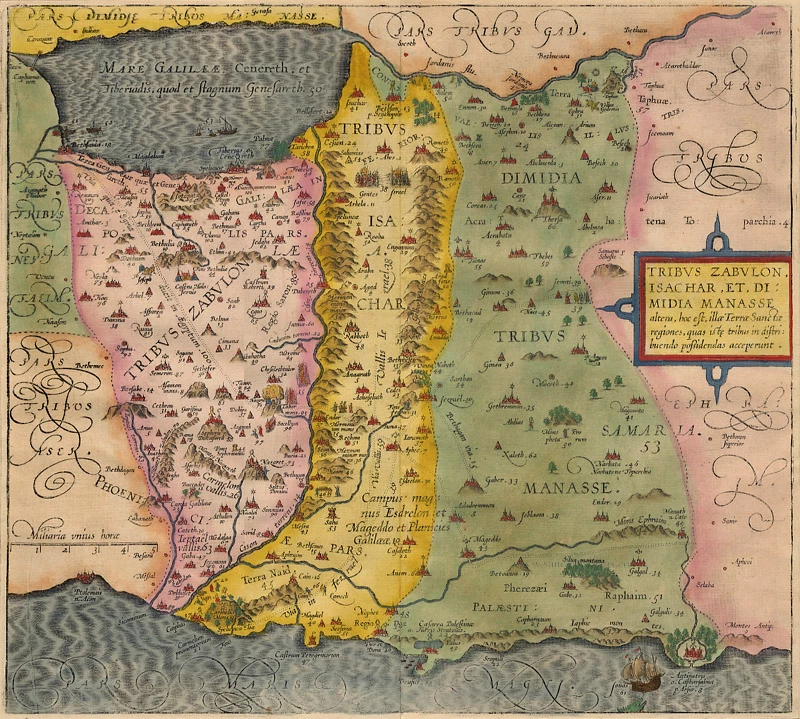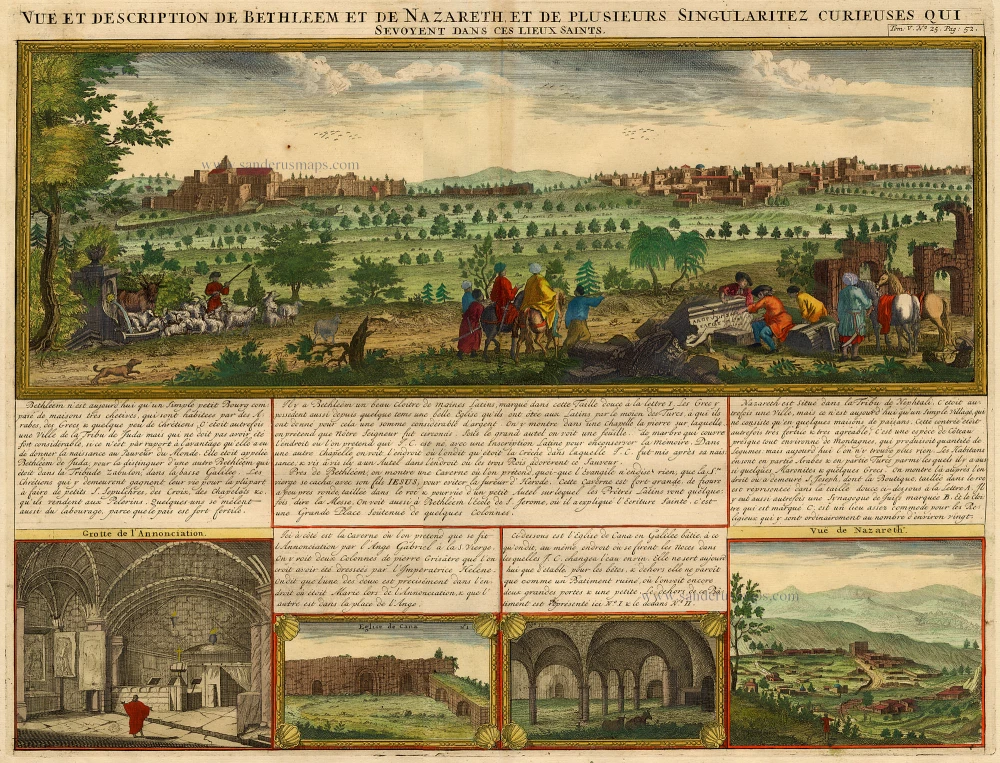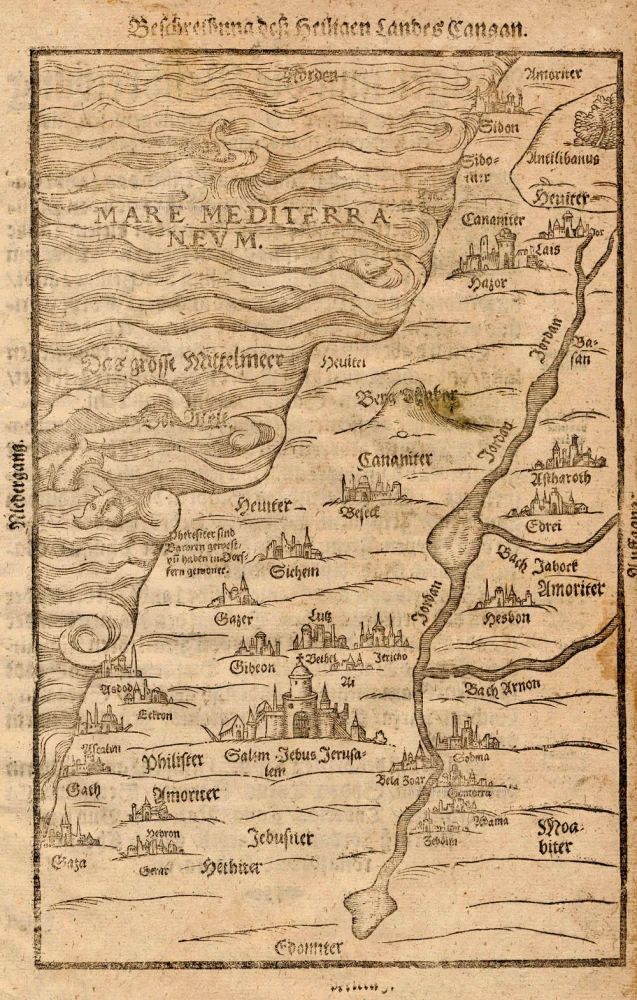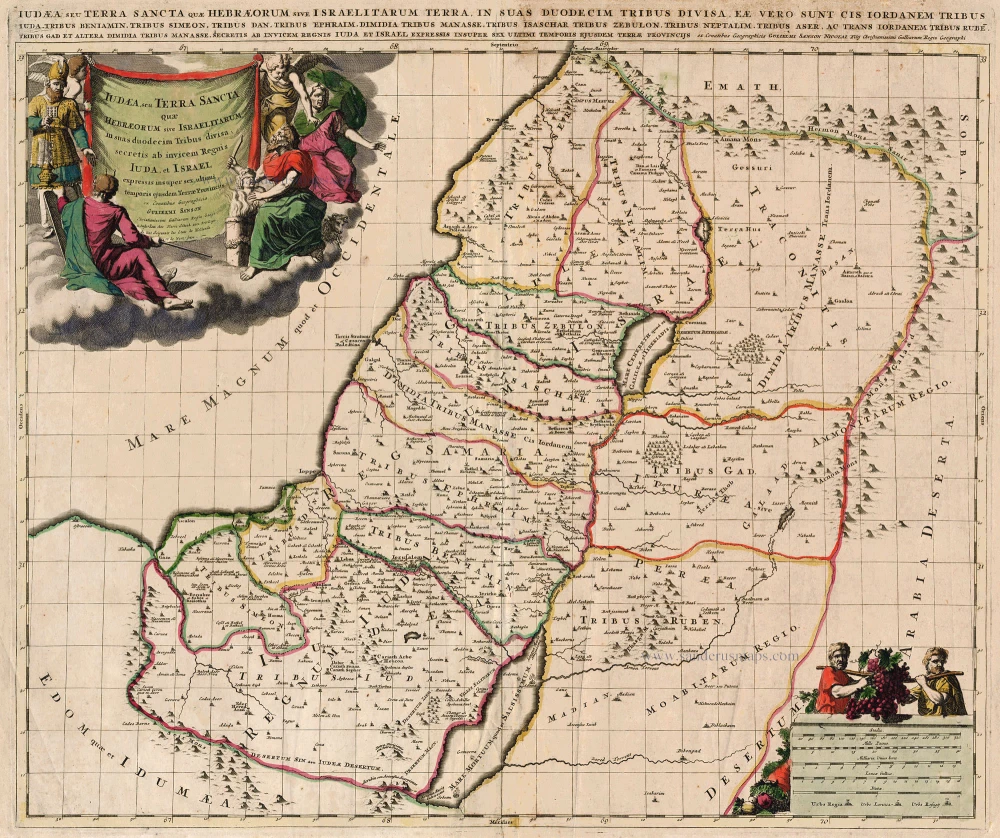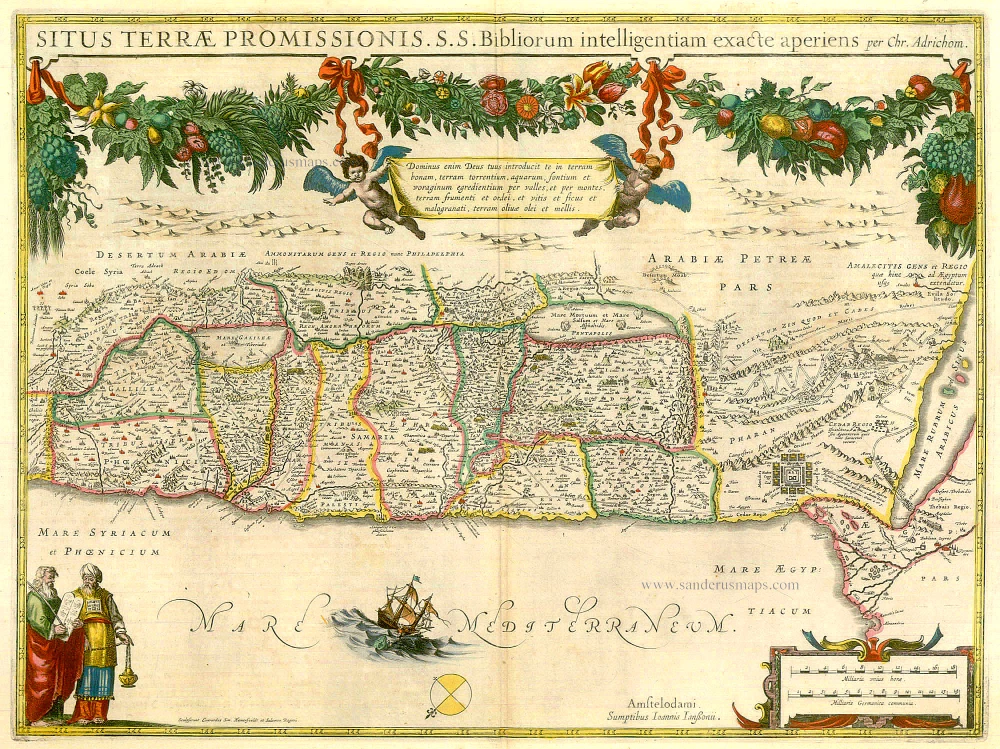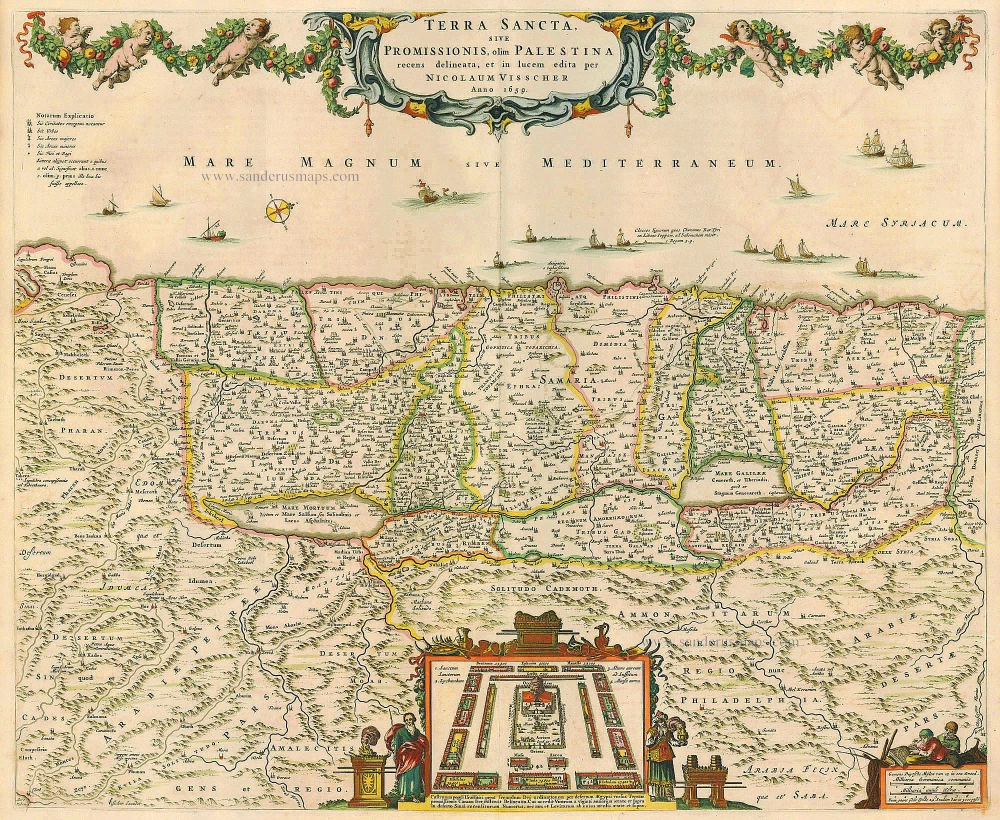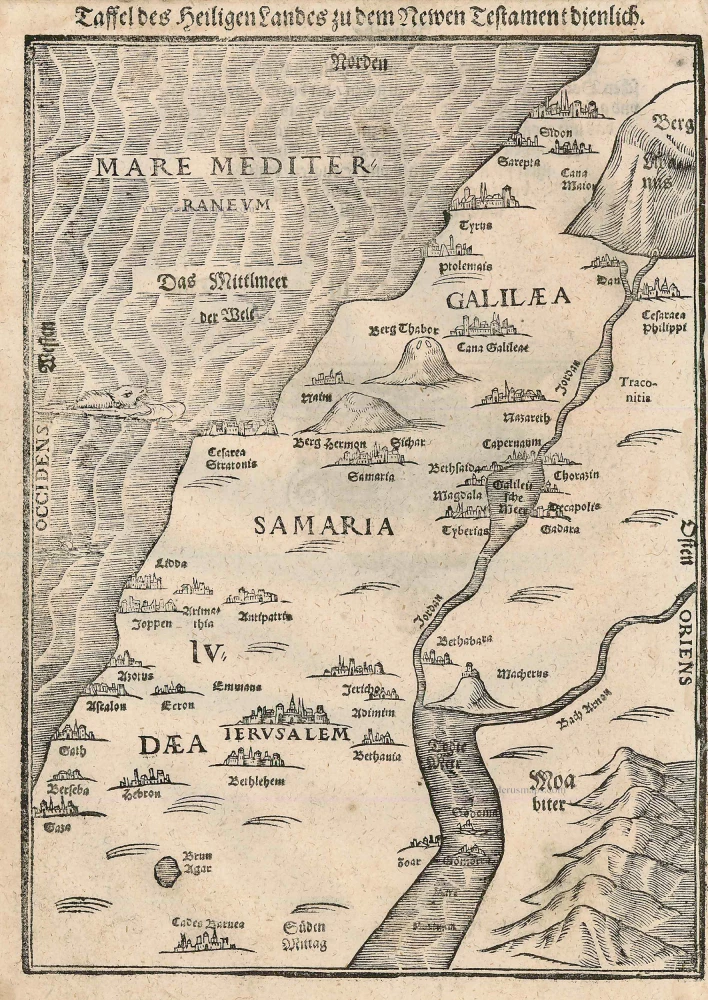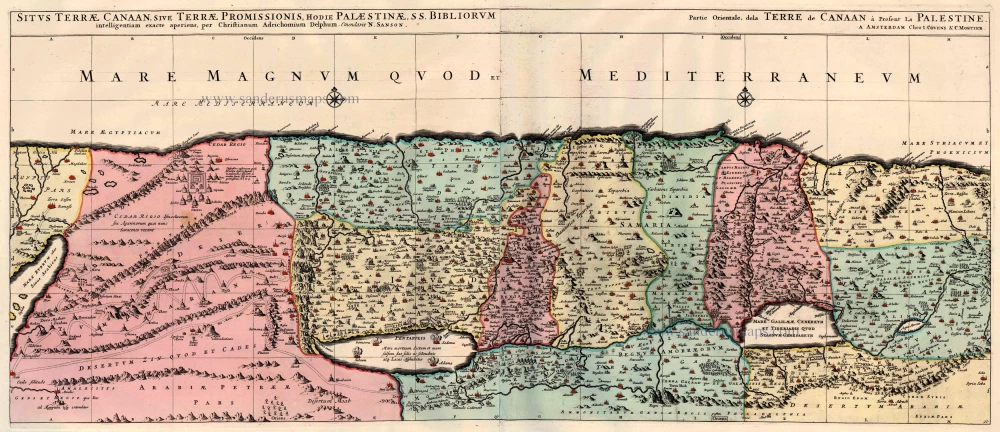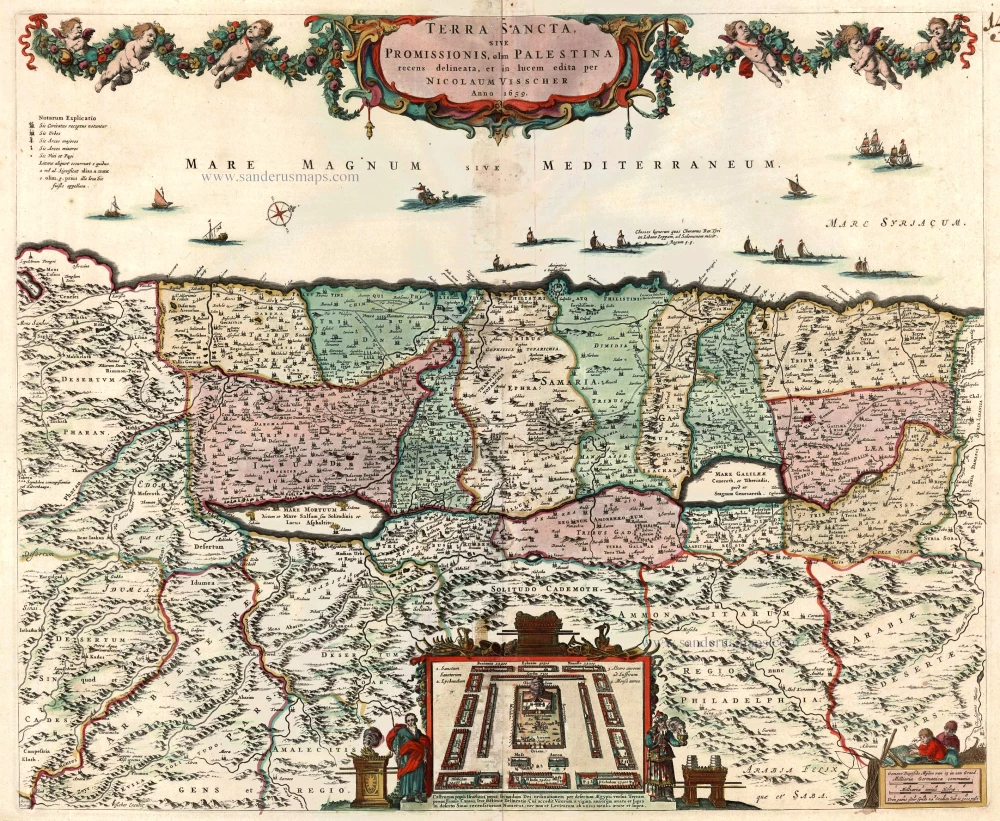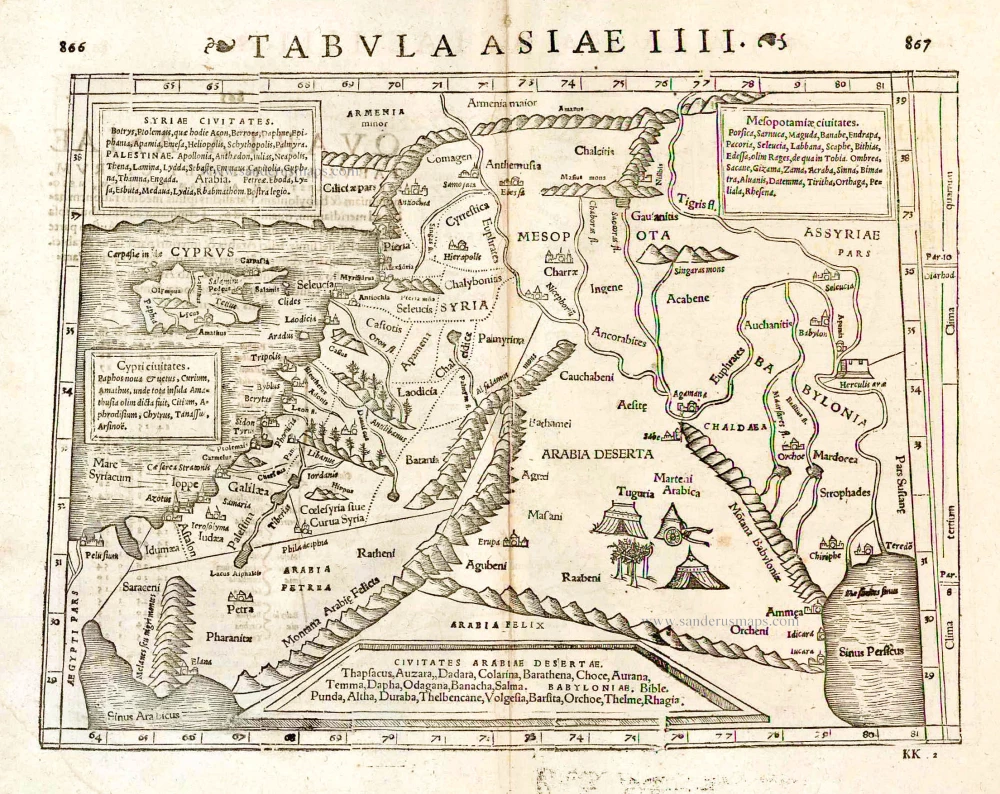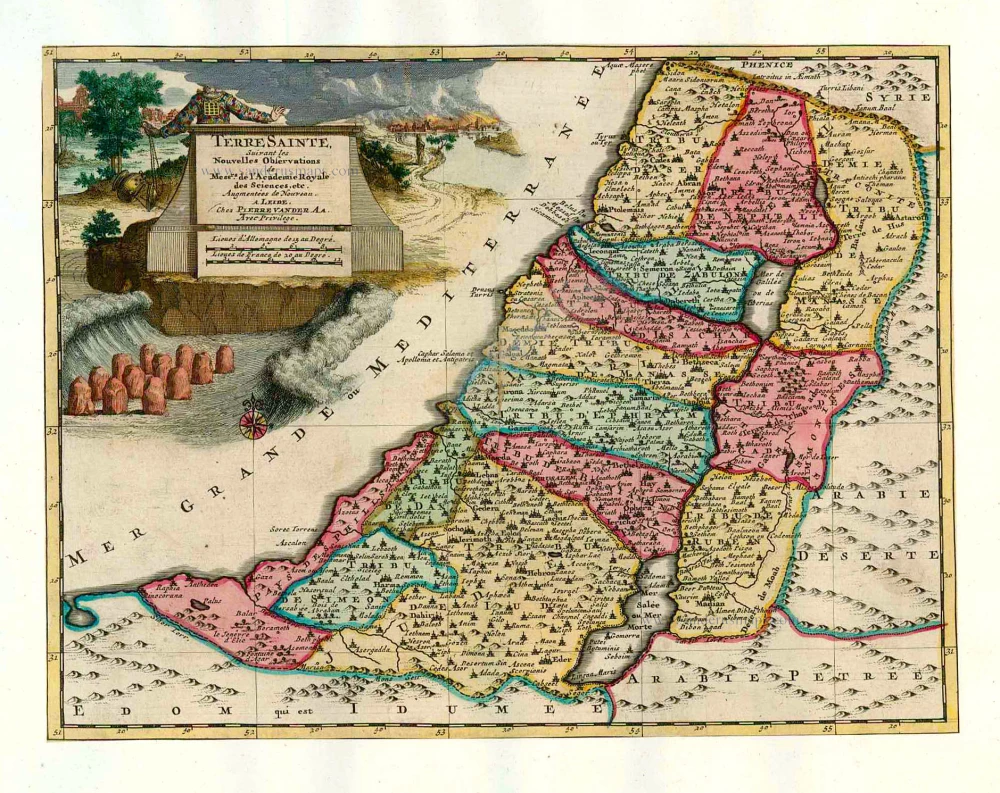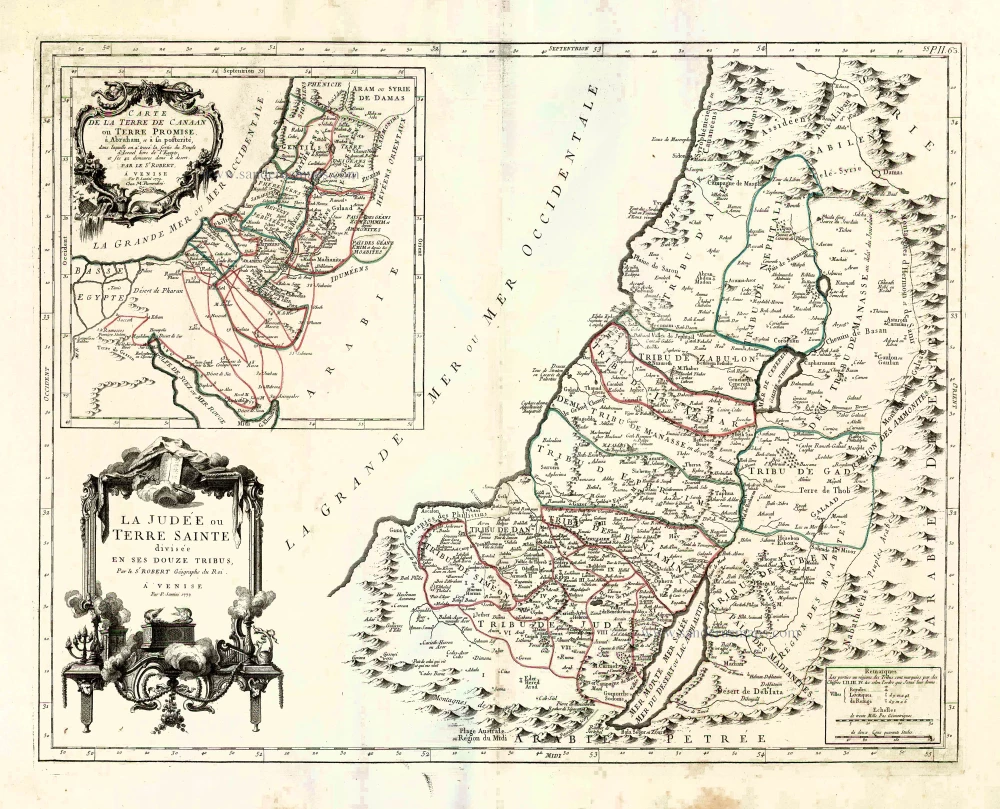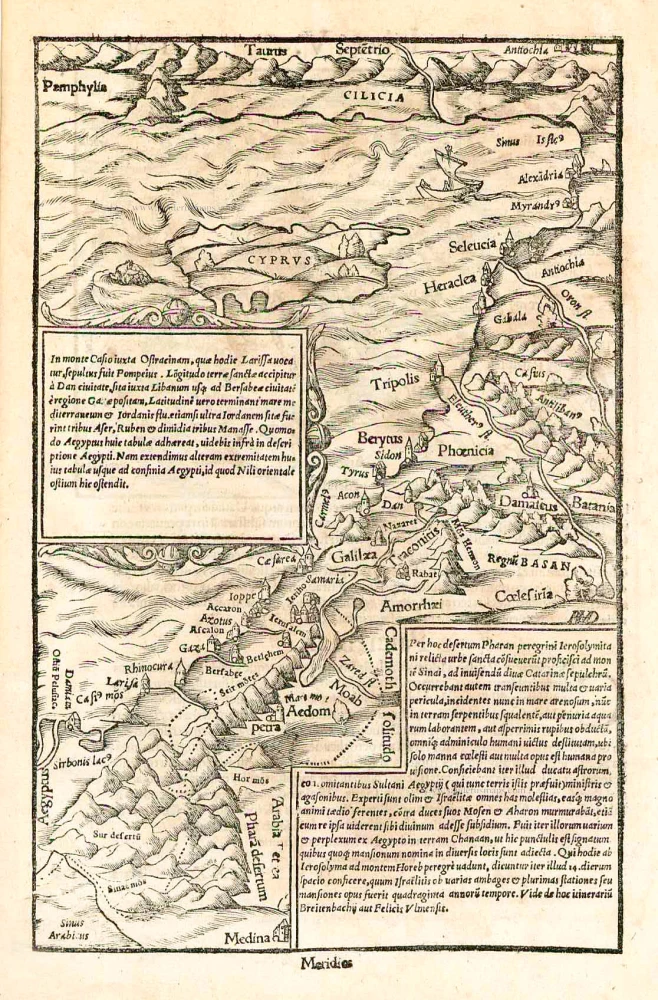Holy Land by Abraham Ortelius 1612
Ortelius included this map, illustrating the land of Canaan in the time of the Patriarchs, in the fourth addition to his atlas in 1590. It became part of the expanding supplement of historical maps, entitled Parergon, that Ortelius appended to his atlas of modern maps. Largerly the work of the master himself, the maps in the Parergon, and this one in particular, are the best engravings that reflect the widespread sixteenth-century interest in classical geography.
The delineation follows closely the already familiar map of Tilleman Stella, the first map of the Holy Land to be included in an Ortelius atlas. Territorial divisions, however, are taken of the story of Abraham in Genesis. Ancient tribal names are preserved in the regions of the Philistines, Amalechites, Jebusites, Cenezites, and Gergesites. The cities of Sodom and Gomorrah still drive along southern Jordan in the "Valley of the Forest of Salt," which was to become the Dead Sea. An inset shows the stages in the wanderings of Abraham, from Ur of the Chaldees, in the lower Euphrates Valley, to Sechem, Bethel, Damascus, Egypt, and Hebron.
In keeping with the title and biblical theme of the engraving, twenty-two medaillions depicting scenes from the life of Abraham surround the map. The map is framed by an inscription containing the promise to Abraham.
The Wanderings of Abraham is among the most elaborate of Ortelius's compositions. It demonstrates his combined skills as a cartographer and an artist, and his accomplishment as an historian. Ortelius imaginatively enlivened the earliest period of biblical history for the readers of his Parergon.
The medaillions have been engraved after designs drawn by Maarten de Vos.
Abraham Ortelius (1527-1598)
The maker of the 'first atlas', the Theatrum Orbis Terrarum (1570), was born on 4 April 1527 into an old Antwerp family. He learned Latin and studied Greek and mathematics.
Abraham and his sisters Anne and Elizabeth took up map colouring. Ortelius was admitted to the Guild of St. Luke as an "illuminator of maps." In addition to colouring maps, Ortelius was a dealer in antiques, coins, maps, and books, and the book and map trade gradually became his primary occupation.
Business went well because his means permitted him to start an extensive collection of medals, coins, antiques, and a library of many volumes. In addition, he travelled a lot, visited Italy and France, made contacts everywhere with scholars and editors, and maintained extensive correspondence with them.
In 1564, he published his first map, a large and ambitious world wall map. The inspiration for this map may well have been Gastaldi's large world map. In 1565, he published a map of Egypt and a map of the Holy Land; a large map of Asia followed.
In 1568, the production of individual maps for his atlas Theatrum Orbis Terrarum was already in full swing. He completed the atlas in 1569, and in May 1570, it was available for sale. It was one of the most expensive books ever published.
This first edition contained seventy maps on fifty-three sheets. Franciscus Hogenberg engraved the maps.
Later editions included Additamenta (additions), resulting in Ortelius' historical atlas, the Parergon, which is mainly bound together with the atlas. The Parergon can be considered a truly original work by Ortelius, who drew the maps based on his research.
The importance of the Theatrum Orbis Terrarum for geographical knowledge in the last quarter of the sixteenth century is difficult to overemphasize. Nothing was like it until Mercator's atlas appeared twenty-five years later. Demand for the Theatrum was remarkable. Some 24 editions appeared during Ortelius's lifetime and another 10 after he died in 1598. Editions were published in Dutch, German, French, Spanish, English, and Italian. The number of map sheets grew from 53 in 1570 to 167 in 1612 in the last edition.
In 1577, engraver Philip Galle and poet-translator Pieter Heyns published the first pocket-sized edition of the Theatrum, the Epitome. The work was trendy. Over thirty editions of this Epitome were published in different languages.
Abrahami Patriarchae Peregrinatio, et Vita.
Item Number: 27265 Authenticity Guarantee
Category: Antique maps > Asia > Holy Land
Old, antique map of the Holy Land, by Abraham Ortelius.
Date of the first edition: 1590
Date of this map: 1612.
Copper engraving, printed on paper.
Size (not including margins): 35.5 x 46cm (13.8 x 17.8 inches)
Verso text: Italian
Condition: Original coloured, centrefold reinforced, minor repairs.
Condition Rating: B
From: Theatro del Mondo di Abrahamo Ortelio. Antwerpen, Plantin Press (J.&B. Moretus), 1612. (Van der Krogt 3, 1:652)
Ortelius included this map, illustrating the land of Canaan in the time of the Patriarchs, in the fourth addition to his atlas in 1590. It became part of the expanding supplement of historical maps, entitled Parergon, that Ortelius appended to his atlas of modern maps. Largerly the work of the master himself, the maps in the Parergon, and this one in particular, are the best engravings that reflect the widespread sixteenth-century interest in classical geography.
The delineation follows closely the already familiar map of Tilleman Stella, the first map of the Holy Land to be included in an Ortelius atlas. Territorial divisions, however, are taken of the story of Abraham in Genesis. Ancient tribal names are preserved in the regions of the Philistines, Amalechites, Jebusites, Cenezites, and Gergesites. The cities of Sodom and Gomorrah still drive along southern Jordan in the "Valley of the Forest of Salt," which was to become the Dead Sea. An inset shows the stages in the wanderings of Abraham, from Ur of the Chaldees, in the lower Euphrates Valley, to Sechem, Bethel, Damascus, Egypt, and Hebron.
In keeping with the title and biblical theme of the engraving, twenty-two medaillions depicting scenes from the life of Abraham surround the map. The map is framed by an inscription containing the promise to Abraham.
The Wanderings of Abraham is among the most elaborate of Ortelius's compositions. It demonstrates his combined skills as a cartographer and an artist, and his accomplishment as an historian. Ortelius imaginatively enlivened the earliest period of biblical history for the readers of his Parergon.
The medaillions have been engraved after designs drawn by Maarten de Vos.
Abraham Ortelius (1527-1598)
The maker of the 'first atlas', the Theatrum Orbis Terrarum (1570), was born on 4 April 1527 into an old Antwerp family. He learned Latin and studied Greek and mathematics.
Abraham and his sisters Anne and Elizabeth took up map colouring. Ortelius was admitted to the Guild of St. Luke as an "illuminator of maps." In addition to colouring maps, Ortelius was a dealer in antiques, coins, maps, and books, and the book and map trade gradually became his primary occupation.
Business went well because his means permitted him to start an extensive collection of medals, coins, antiques, and a library of many volumes. In addition, he travelled a lot, visited Italy and France, made contacts everywhere with scholars and editors, and maintained extensive correspondence with them.
In 1564, he published his first map, a large and ambitious world wall map. The inspiration for this map may well have been Gastaldi's large world map. In 1565, he published a map of Egypt and a map of the Holy Land; a large map of Asia followed.
In 1568, the production of individual maps for his atlas Theatrum Orbis Terrarum was already in full swing. He completed the atlas in 1569, and in May 1570, it was available for sale. It was one of the most expensive books ever published.
This first edition contained seventy maps on fifty-three sheets. Franciscus Hogenberg engraved the maps.
Later editions included Additamenta (additions), resulting in Ortelius' historical atlas, the Parergon, which is mainly bound together with the atlas. The Parergon can be considered a truly original work by Ortelius, who drew the maps based on his research.
The importance of the Theatrum Orbis Terrarum for geographical knowledge in the last quarter of the sixteenth century is difficult to overemphasize. Nothing was like it until Mercator's atlas appeared twenty-five years later. Demand for the Theatrum was remarkable. Some 24 editions appeared during Ortelius's lifetime and another 10 after he died in 1598. Editions were published in Dutch, German, French, Spanish, English, and Italian. The number of map sheets grew from 53 in 1570 to 167 in 1612 in the last edition.
In 1577, engraver Philip Galle and poet-translator Pieter Heyns published the first pocket-sized edition of the Theatrum, the Epitome. The work was trendy. Over thirty editions of this Epitome were published in different languages.






